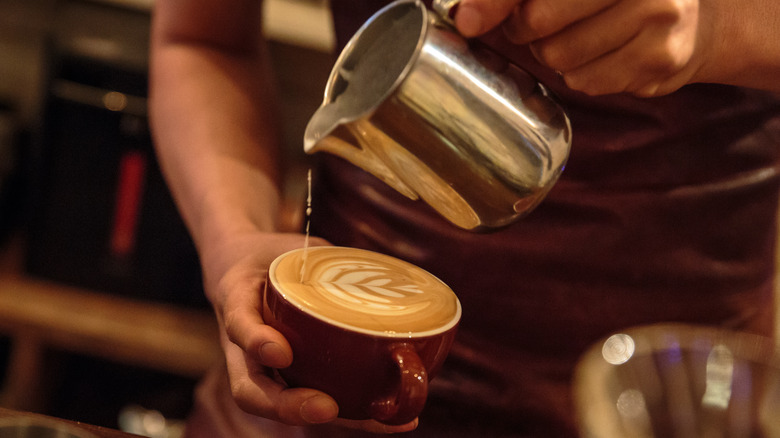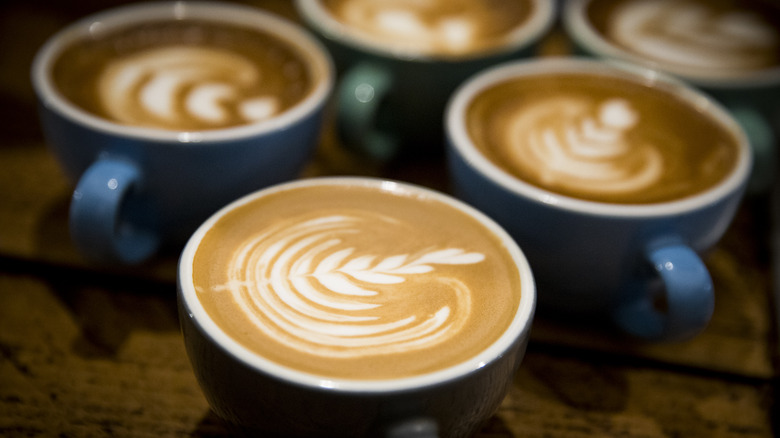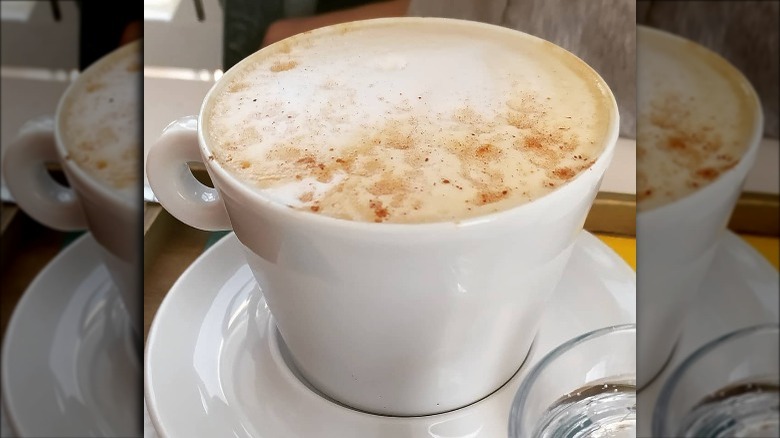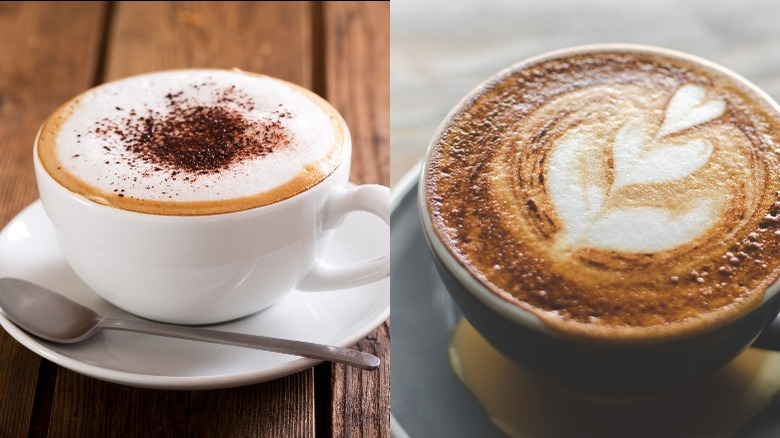The Real Difference Between Lattes And Cappuccinos
Every day, people order their usual coffee beverage while looking at a menu with varying types of what most coffee shops call "espresso drinks," but very few people can describe the difference between a latte and a cappuccino, even though they have probably tried both. When you get into the more elaborate upmarket drinks, the differences can be subtle, which can lead to confusion. With a simple breakdown, these differences are much easier to understand.
A cappuccino and a latte are both Italian coffee drinks. The modern cappuccino evolved after World War II as better espresso machines became more readily available in Europe (via The Spruce Eats). It then reached America around 1980 when coffee shops began marketing them (via Roasty).
Cappuccinos are made by adding steamed milk and foam to a shot of espresso. The drink is equal parts espresso, steamed milk, and foam, resulting in a creamy drink with a rich flavor (via Healthline). A key aspect of the cappuccino is the foam, which should be dense. Some coffee shops will offer toppings such as cacao powder, cinnamon, or whipped cream for your cappuccino as well (via Coffee Bros.).
A latte, or cafe latte, translates directly to "coffee milk." Lattes were originally served in glasses, not mugs, and still are in many parts of the world, including some coffee shops in the United States which still stick to that tradition. A latte consists of adding steamed milk to a shot of espresso, topped with a little bit of foam.
Proportion is important with lattes and cappuccinos
This is where a lot of the confusion comes from. The ingredients in a cappuccino and latte are the same, but the difference is in the proportions. Lattes contain more steamed milk than cappuccinos (where all ingredients are the same amount across the board), which in turn gives lattes a milder flavor than cappuccinos. Due to the ratio difference, there is more liquid in a latte because of the higher proportion of steamed milk. If both drinks were left to sit so that the foam collapses, the cappuccino will look significantly smaller.
Most coffee shops serve lattes in larger sizes than the traditional 8 ounces. To maintain the proportion of approximately one shot of espresso to 6 ounces of steamed milk, a small or medium latte ordered at a coffee shop may contain two shots of espresso.
For social media enthusiasts, lattes have more recently been served with ever more impressive foam art created by the baristas making them, so lattes are the more Instragrammable drink.
What are the nutritional differences between a cappuccino and a latte?
Which drink should you choose if you're counting calories or calcium — a latte or a cappuccino? Furthermore, which non-dairy milk alternative is healthiest? Let's consider a drink with two shots, or two ounces, of espresso. According to Coffee Bros., a conventional double latte will be 8 ounces — so that's 6 ounces of milk. A double cappuccino will have two ounces of milk and two ounces of foam. (We'll disregard any nutritional info for foam, since it's mostly air.)
Lattes clearly have more calories. Two shots of espresso total five calories, according to Livestrong. Per Nutritionix, the six ounces of whole milk in a latte has 114 calories. At two ounces, the milk in the cappuccino contributes 38 calories. In total, the latte packs 119 calories, compared to 43 in the cappuccino. But the latte delivers more of the nutrients found in milk: 21% of your calcium needs vs. 7% in the cappuccino, and 6 grams of protein vs. the cappuccino's 2 grams.
The bottom line on plant-based milks is that each has something to offer nutritionally. Healthline gives a rundown of popular alternative milks and notes that soy milk brings the protein, while oat milk is naturally sweet and high in fiber. Almond milk is low in calories and naturally high in vitamin E, but read the label because it often includes added sugar. Coconut milk has no protein to speak of, but the fat in coconuts is the heart-healthy kind.
Cappuccino or latte: how to choose?
Now that you know how to distinguish a latte from a cappuccino, you're faced with a choice: Which one is going to be your go-to beverage? If you enjoy a stronger coffee flavor, go with the cappuccino. Coffee Bros. points out that cappuccinos can have half the amount of steamed milk as lattes, so get the latte if a cup of warm milk with a little added coffee sounds good. Cappuccinos have less liquid overall, so if you're in a hurry and looking for a quick caffeine hit or a jolt of warmth, order the cappuccino.
If you're trying to limit (or maximize!) your caffeine intake, then it's a toss-up. Either drink with a single shot of espresso delivers 63 mg of caffeine, according to Consumer Reports (75 mg if you go to Starbucks).
Maybe your personality type will help you figure out which coffee beverage you prefer. Women's LifeStyle asked a professional barista for insight into the types of people who order lattes and cappucinos. A lot of latte drinkers either don't like coffee very much or want to go with what everyone else tends to order, the barista said. Cappuccino drinkers are fancier or might like their beverages a little sweeter.
Dr. Ramani Durvasula, a clinical pyschologist, studied 1,000 coffee drinkers to match their personality types with their preferred drink (via Daily Mail). Dr. Durvasula concluded latte drinkers were people pleasers, while cappuccino drinkers tended to be obsessive and controlling. But take the good doctor's conclusions with a grain of salt — or even better, stir in a spoonful of sugar.



